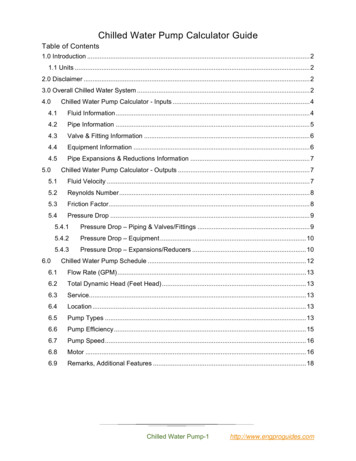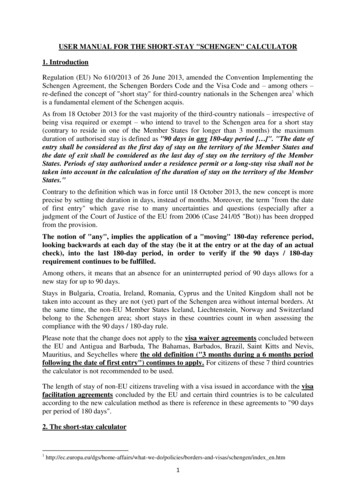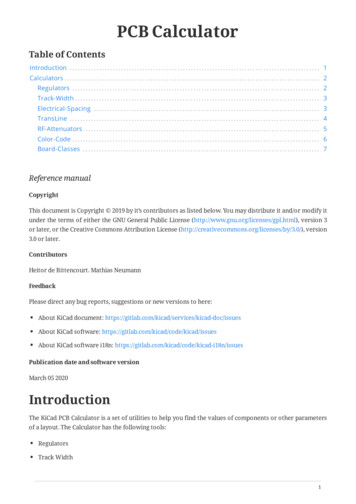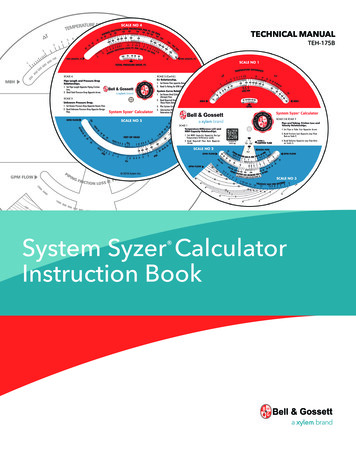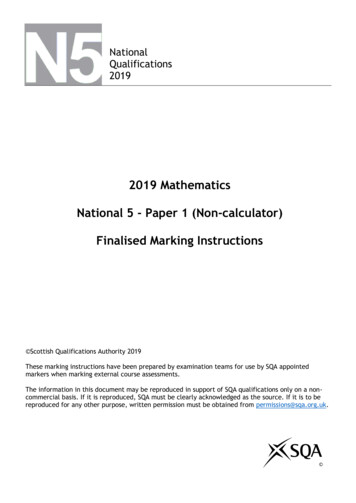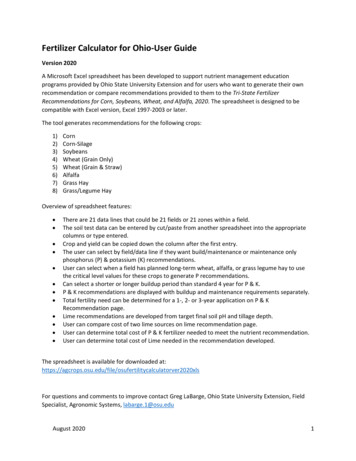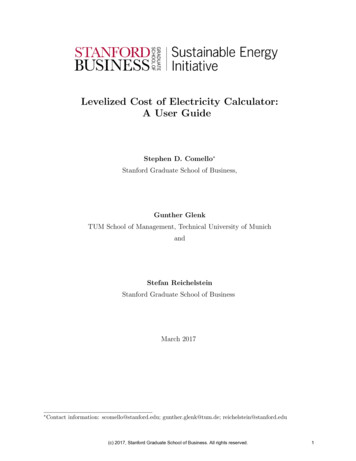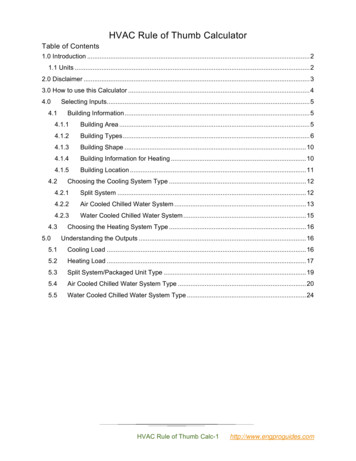
Transcription
HVAC Rule of Thumb CalculatorTable of Contents1.0 Introduction . 21.1 Units . 22.0 Disclaimer . 33.0 How to use this Calculator . 44.0Selecting Inputs. 54.1Building Information . 54.1.1Building Area . 54.1.2Building Types . 64.1.3Building Shape . 104.1.4Building Information for Heating . 104.1.5Building Location . 114.2Choosing the Cooling System Type . 124.2.1Split System . 124.2.2Air Cooled Chilled Water System . 134.2.3Water Cooled Chilled Water System . 154.35.0Choosing the Heating System Type . 16Understanding the Outputs . 165.1Cooling Load . 165.2Heating Load . 175.3Split System/Packaged Unit Type . 195.4Air Cooled Chilled Water System Type . 205.5Water Cooled Chilled Water System Type . 24HVAC Rule of Thumb Calc-1http://www.engproguides.com
1.0 INTRODUCTIONDuring the early stages of HVAC design, it is important to be able to quickly determine theoverall size of an HVAC system in order to assist the owner and/or architect space plan anddetermine rough costs. At these early stages, the space changes very quickly and the ownerand/or architect need immediate feedback to be able to ensure that there is adequate space formechanical equipment and there is sufficient funds.It takes years of experience to be able to quickly select an HVAC system type, size the HVACsystem and cost the HVAC system, with limited information. After designing a multitude ofHVAC systems for all sorts of buildings, you should be able toThe calculator uses the building square footage, building usage type and building shape toautomatically determine the maximum and minimum overall tonnage and electrical usage of theequipment for multiple HVAC systems. The HVAC systems analyzed in this calculator include(1) split systems/packaged A/C, (2) air cooled chilled water systems and (3) water cooled chilledwater systems. This will help you to select equipment, space plan for any mechanical roomsand ceiling space and create a budget. Also by providing electrical values for the equipment,the electrical engineer can also plan for utility service, transformers and panels.Figure 1: The three systems available in this calculator are the (1) split system, packaged A/C, (2) aircooled chilled water and (3) water cooled chilled water.1.1 UNITSThere are two calculators, (1) one that focuses on United States Customary System Units(USCS) and another on (2) International System of Units (SI). However, this guide focusesexclusively on the USCS.HVAC Rule of Thumb Calc-2http://www.engproguides.com
Table 1: This table shows a list of the popular unit conversions applicable for this calculator.1111111Btu/hBtu/hBtu/hEERSEERfeetlb 8.33 x10-52.93 meterkg1111111tonkWWkW/tonkW/tonmeterkg EERfeetlb111111111111111ft2galft3fpmgpmcfmin. wgft. hdpsipsipsilb/ft3BtuBtu/hHP 0.0934.410.1335.08x10-30.0630.472249.092.996.89 m/sl/sl/sPaPaMPain. wgft. sl/sPaPaMPain. wgft. hdkg/m3watthourHPkW 10.76390.2277.481195.8515.852.1194.01 x10-33.34 pmgpmcfmin. wgft. hdpsipsipsilb/ft3BtuBtu/hHPThere are two main sets of units that should be discussed in more detail, (1) EER and (2)SEER. First, you need to understand that the efficiency of air conditioners in the refrigerationcycle is greatly dependent on the heat rejection provided at the evaporator and condenser. Inthe first figure, you can see that the heat rejection at the evaporator and condenser change fromair to water as you move from split system to water cooled chilled water system. This change inheat rejection from air to water greatly improves the efficiency because the heat transfer ismuch better with water due to its increased heat capacity.EER: The Energy Efficiency Ratio or EER is the ratio of the total cooling Btu/h to the total inputpower in watts. The conversion from EER to kW/ton is shown below.111 112,000 10.001112SEER: The Seasonal Energy Efficiency Ratio or SEER is similar to EER2.0 DISCLAIMERIn no event will Engineering Pro Guides be liable for any incidental, indirect, consequential,punitive or special damages of any kind, or any other damages whatsoever, including, withoutHVAC Rule of Thumb Calc-3http://www.engproguides.com
limitation, those resulting from loss of profit, loss of contracts, loss of reputation, goodwill, data,information, income, anticipated savings or business relationships, whether or not EngineeringPro Guides has been advised of the possibility of such damage, arising out of or in connectionwith the use of this document/software or any referenced documents and/or websites.3.0 HOW TO USE THIS CALCULATORThis book should be used in conjunction with the excel spreadsheet titled HVAC Rule of ThumbCalculator. This book provides you more background knowledge on inputs (Section 4.0) andunderstanding and interpreting the outputs (Section 5.0).When using this calculator, first you should enter your building inputs. These inputs are theminimum amount of information necessary to produce a reliable analysis on your HVACrequirements. There are certain inputs that are from a drop down menu and contain only a setamount of options. If you feel that your building cannot be characterized by one of the options,then you can override the drop down menu. Please only override the option after reading thismanual in order to understand how each input affects your analysis.Second, you need to choose your system type. The available options for system types are (1)split system, (2) air cooled chilled water and (3) water cooled chilled water. There is moredescription on each of the system types. Your system type may not exactly fit one of thesethree system types, due to the many variations in HVAC system types. However, the systemtypes and this calculator are only used to calculate overall sizes of major HVAC equipment.You may have variations like an energy recovery system or a reheat system that are notincluded, but the main equipment will be accounted for in this calculator.Finally, you need to read and interpret your results. The results are meant to guide spaceplanning and budgeting during the initial stages of design. The results can also be used todouble check a preliminary or final design to ensure the design falls within the ranges presentedin the calculator. A design that occurs outside of the range may be a sign of a significantproblem in the design. These results are not meant to finalize or to purchase equipment. Acomplete and detailed calculation should be conducted to get more exact results for thesepurposes.HVAC Rule of Thumb Calc-4http://www.engproguides.com
4.0 SELECTING INPUTS4.1BUILDING INFORMATIONThe first step in using the HVAC Rule of Thumb Calculator is to input the building informationlike the building air conditioned area, building type, building shape and building location. Eachof these options will be discussed in further detail in this section.4.1.1 BUILDING AREAThe building area is not the total area, but only the area of the building that will be airconditioned. For example, mechanical/electrical rooms, bathrooms, storage rooms are often notair conditioned. Non-air-conditioned areas should be excluded from the building area input.Table 2: Only use the air conditioned area in the building area input section of the calculator.Sample Office BuildingSpaceArea (ft2)HVAC Area (ft2)Private officesConference roomsCubiclesBreak roomsStorage roomsBathroomsMechanical roomsElectrical 0,00010,00080,00010,0000000Total127,000110,000In the sample office building above, you would use the 110,000 ft2 value in the HVAC Rule ofThumb Calculator.If you have multiple floors, then add up all the air conditioned area for all floors and insert asingle number for the HVAC Building Area value. The floor input is only used to calculate theroof area, which is used in the heating load calculations.Sample Office BuildingSpaceArea (ft2)HVAC Area (ft2)1st Floor2nd HVAC Rule of Thumb Calc-5http://www.engproguides.com
4.1.2 BUILDING TYPESThe building type is used to provide the appropriate square foot per ton value and airflow (CFM)per square foot value.Apartment, Mid/High Rise:Description: This building type can be used for apartments orcondominiums that are larger than single family homes or multi-familydwellings. An apartment building under this type can be a high risetype with more than 10 floors or a mid-rise with 5 to 10 floors. Theseapartments are often served by a central HVAC system, but can alsobe served by individual split systems per apartment. The units withinthe apartment can be studios, one-bedroom and larger units.Cooling Load: The higher tonnage and airflow values correspond toapartments in hotter/more humid climates with larger amounts ofexternal fenestration (windows and/or skylights).Auditorium, Church, Theater:Description: Auditoriums, churches and theaters are characterized bya high people density values. These people also have a sedentaryactivity level. These types of buildings have high people cooling loadsand high amounts of outside air requirements. Other assembly areaslike cafeterias can also use this building type. Kitchens should not beincluded in the cafeteria area, because kitchen loads are basedprimarily on the specific equipment.Cooling Load: The higher tonnage and airflow values correspond tobuildings that are located in hotter/more humid climates, because theprimarily load within these types of buildings will be due to the largeamounts of ventilation air required for all the people. The lowertonnage and airflow values correspond to buildings with a highersquare foot per person value. Typically, you will not be in the 400sf/ton range because these types of buildings try to fit as many peopleas possible. A value in the 250 sf/ton and 1.5 cfm/sf range is mostlikely.Elementary, High School, College:Description: This building type can be used for elementary schools,high school, universities and colleges. Unfortunately, this building typecannot be used for pre-school and child care facilities. This buildingtype is characterized by primarily classroom type spaces with highpeople density values. There can be ancillary air conditioned spaceslike offices and assembly areas within this building type, assumingthese spaces do not exceed 20% of the total building area. If you havelarge office spaces or assembly areas, then break out those areas witha separate calculator.Cooling Load: Similar to the previous entry on assemblies, the highertonnage and airflow values correspond to buildings with higher squarefoot per person values and buildings that are located in hotter andmore humid climates.HVAC Rule of Thumb Calc-6http://www.engproguides.com
Factory, Industrial:Description: Factories and industrial type buildings typically have lowexternal loads, low people loads, but high equipment loads. Theseloads are primarily sensible, which causes higher airflow requirements.There may be small ancillary conference rooms or office rooms thatsupport the building, which you can still include in the area as long asthese ancillary spaces do not exceed 20% of the total building area.Cooling Load: The higher tonnage and airflow values correspond tobuildings with a higher density of equipment that either require fresh airor emit large amounts of heat. The location shouldn’t affect buildingsthat have minimal fresh air requirements, because these factories andindustrial type buildings rarely have fenestration.Hospital, Medical:Description: Hospitals and medical facilities consist of primarily patientrooms, doctor’s offices, nurse stations, waiting areas and supportancillary
HVAC Rule of Thumb Calc-1 http://www.engproguides.com HVAC Rule of Thumb Calculator Table of Contents 1.0 Introduction . 2
